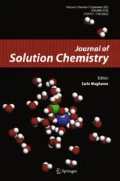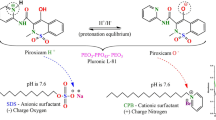Abstract
In the present study, we have examined the mixed micellization behavior of promethazine hydrochloride (PMT) and the nonionic surfactant Triton X-100 mixtures at different mole fractions of TX-100 (α1) in aqueous solutions with and without additives (CTAB, glycine, vitamin-C and PVP) using conductometric, tensiometric and fluorescence techniques. PMT belongs to a class of amphiphilic drugs called phenothiazines and is used as an antihistamine, analgesic and sedative. Various parameters which include the ideal critical micelle concentration (cmcid), ideal micellar mole fraction, \(X_{1}^{\text{id}}\), of TX-100, micellar composition, \(X_{1}^{\text{mic}}\), of TX-100, interaction parameter (β), activity coefficients (\(f_{1}^{\text{mic}}\) and \(f_{2}^{\text{mic}}\)), thermodynamic parameters \(\left( {\Delta G_{\text{mic}}^{ 0} , \;\Delta G_{\text{ad}}^{0} \;{\text{and}}\;\Delta G_{\text{mic}}^{\text{E}} } \right)\) and interfacial parameters (Γmax, Amin, and Πcmc) have been calculated by using Clint’s and Rubingh’s models. In our study, we have found that the cmc < cmcid, β < 0 and \(f_{1}^{\text{mic}}\) and \(f_{2}^{\text{mic}}\) < 1; all the mixtures show synergism \(X_{1}^{\text{id}}\) as well as non-ideality. The values of \(\Delta G_{\text{ad}}^{0} > \Delta G_{\text{mic}}^{ 0}\) for all the systems indicate that adsorption phenomenon occurs primarily as compared to the micellization process. The negative values of \(\Delta G_{\text{mic}}^{\text{E}}\) for all α1 in the absence and presence of additives indicate greater stability of the micelles of mixtures than for the micelles of pure components. The interfacial parameters give information about the packing of amphiphilic molecules.








Similar content being viewed by others
References
Hill, R.M., Ogino, K., Abe, M. (eds.): Mixed Surfactant Systems, Surfactant Science Series. Marcel Dekker, New York (1993)
Farooq, U., Ali, A., Patel, R., Malik, N.A.: Interaction between amphiphilic antidepressant drug nortryptyline hydrochloride and conventional cationic surfactants: a physicochemical study. J. Mol. Liq. 233, 310–318 (2017). https://doi.org/10.1016/j.molliq.2017.03.032
Schreier, S., Malheiros, S.V., de Paula, E.: Surface active drugs: self-association and interaction with membranes and surfactants. Physicochemical and biological aspects. Biochim. Biophys. Acta 1508, 210–234 (2000)
Maurya, N., Parray ud din, M., Maurya, J.K., Kumar, A., Patel, R.: Interaction of promethazine and adiphenine to human hemoglobin: a comparative spectroscopic and computational analysis. Spectrochim. Acta Part A 199, 32–42 (2018). https://doi.org/10.1016/j.saa.2018.03.023
Attwood, D., Florence, A.T.: Surfactant Systems: Their Chemistry, Pharmacy and Biology. Chapman and Hall, New York (1983)
He, L.L., Wang, Z.X., Wang, Y.X., Liu, X.P., Yang, Y.J., Gao, Y.P., Liu, B.: Studies on the interaction between promethazine and human serum albumin in the presence of flavonoids by spectroscopic and molecular modeling techniques. Colloids Surf. B 145, 820–829 (2016). https://doi.org/10.1016/j.colsurfb.2016.06.001
Kralova, I., Sjöblom, J.: Surfactants used in food industry: a review. J. Disp. Sci. Technol. 30, 1363–1383 (2009)
Rosen, M.J.: Surfactants and Interfacial Phenomena, 3rd edn. Wiley, New York (2004)
Tadros, T.F.: Applied Surfactants: Principles and Applications. Wiley, New York (2005)
Menger, F.M., Littau, C.A.: Gemini-surfactants: synthesis and properties. J. Am. Chem. Soc. 113, 1451–1452 (1991)
Kumar, D., Rub, M.A., Akram, M., Kabir-ud-Din.: Interaction of chromium(III) complex of glycylphenylalanine with ninhydrin in aqueous and cetyltrimethylammonium bromide (CTAB) micellar media. Tenside Surfactants Deterg. 51, 157–163 (2014). https://doi.org/10.3139/113.110296
Kumar, D., Rub, M.A., Akram, M., Kabir-ud-Din, : Effect of gemini (alkanediyl-α,ω-bis(dimethylcetylammonium bromide)) (16-s-16, s = 4,5, 6) surfactants on the interaction of ninhydrin with chromium-glycylphenylalanine. Spectrochimica Acta Part A 132, 288–294 (2014). https://doi.org/10.1016/j.saa.2014.05.002
Lipinski, C.A.: Avoiding investment in doomed drugs. Curr. Drug Discov. 1, 17–19 (2001)
Lipinski, C.A.: Poor aqueous solubility—an industry-wide problem in drug discovery. Am. Pharm. Rev. 5, 82–85 (2002)
Akram, M., Anwar, S., Kabir-ud-Din.: Biophysical investigation of promethazine hydrochloride binding with micelles of biocompatible gemini surfactants: combination of spectroscopic and electrochemical analysis. Spectrochim. Acta Part A 215, 249–259 (2019). https://doi.org/10.1016/j.saa.209.02.082
Lawrence, M.J., Rees, G.D.: Microemulsion-based media as novel drug delivery systems. Adv. Drug Deliv. Rev. 64, 175–193 (2012). https://doi.org/10.1016/j.addr.2012.09.018
Nakano, M.: Places of emulsions in drug delivery. Adv. Drug Deliv. Rev. 45, 1–4 (2000). https://doi.org/10.1016/S0169-409X(00)00096-X
Leuner, C., Dressman, J.: Improving drug solubility for oral delivery using solid dispersions. Eur. J. Pharm. Biopharm. 50, 47–60 (2000). https://doi.org/10.1016/S0939-6411(00)00076-X
Hennenfent, K.L., Govindan, R.: Novel formulations of taxanes: a review. Old wine in a new bottle? Ann. Oncol. 17, 735–749 (2005). https://doi.org/10.1093/annonc/mdj100
Gaucher, G., Marchessault, R.H., Leroux, J.C.: Polyester-based micelles and nanoparticles for the parental delivery of taxanes. J. Control Release 143, 2–12 (2010). https://doi.org/10.1016/j.jconrel.2009.11.012
Rub, M.A., Naqvi, A.Z.: Mixed micellization between an antidepressant drug imipramine hydrochloride and surfactants (conventional/gemini) at different temperatures and compositions. J. Solution Chem. 44, 2448–2469 (2015). https://doi.org/10.1007/s10953-015-0412-3
Kabir-ud-Din, Rub, M.A., Naqvi, A.Z.: Mixed micelles of amphiphilic drug promethazine hydrochloride and surfactants (conventional and gemini) at 293.15 K to 308.15 K: Composition, interaction and stability of the aggregates. J. Colloid Interface Sci. 354, 700–708 (2011). https://doi.org/10.1016/j.jcis.2010.11.005
Mahajan, R.K., Mahajan, S., Bhadani, A., Singh, S.: Physicochemical studies of pyridinium gemini surfactants with promethazine hydrochloride in aqueous solution. Phys. Chem. Chem. Phys. 14, 887–898 (2012). https://doi.org/10.1039/C1CP22448D
Heinig, K., Vogt, C.: Determination of Triton X-100 in influenza vaccine by high-performance liquid chromatography and capillary electrophoresis. Fresenius J. Anal. Chem. 359, 202–206 (1997)
Behera, K., Pandey, S.: Interaction between ionic liquid and zwitterionic surfactant: a comparative study of two ionic liquids with different anions. J. Colloid Interface Sci. 331, 196–205 (2009). https://doi.org/10.1016/j.jcis.2008.11.008
Banerjee, P., Chatterjee, S., Pramanik, S., Bhattacharya, S.C.: Interaction of pyrene-1-carboxaldehyde with micelles and mixed micelles of polyoxyethylenenonyl phenol (lgepal): a spectroscopic study. Colloids Surf. A 302, 44–50 (2007). https://doi.org/10.1016/j.colsurfa.2007.01.038
Chauhan, S., Sharma, K.: Effect of temperature and additives on the critical micelle concentration and thermodynamics of micelle formation of sodium dodecyl benzene sulfonate and dodecyltrimethylammonium bromide in aqueous solution: a conductometric study. J. Chem. Thermodyn. 71, 205–211 (2014). https://doi.org/10.1016/j.jct.2013.12.019
Sarkar, B., Lam, S., Alexandridis, P.: Micellization of alkyl-propoxy-ethoxylate surfactants in water–polar organic solvent mixtures. Langmuir 26, 10532–10540 (2010)
Yan, S., Wei, A.W., Gao, A.Z., Xiaab, A.Y., Han, J.: Gemini surfactant with pyrrolidinium head groups and a hydroxyl-substituted spacer: surface properties and assisted one-pot synthesis of dendritic Au nanocrystals. New J. Chem. 42, 11573–11582 (2018). https://doi.org/10.1039/c8nj01357h
Rub, M.A., Azum, N., Asiri, A.M., Kashmery, H.A., Alfaifi, S.Y.M., Alharthi, S.S.: Effect of sodium dodecylbenzenesulfonate on the association behavior of promethazine hydrochloride in aqueous/electrolyte solutions at different temperatures. J. Solution Chem. 46, 862–885 (2017). https://doi.org/10.1007/s10953-017-0614-y
Kumar, D., Rub, M.A.: Effect of anionic surfactant and temperature on micellization behavior of promethazine hydrochloride drug in absence and presence of urea. J. Mol. Liq. 238, 389–396 (2017). https://doi.org/10.1016/j.molliq.2017.05.027
Rub, M.A., Khan, F., Kumar, D., Asiri, A.M.: Study of mixed micelles of promethazine hydrochloride (PMT) and nonionic surfactant (TX-100) mixture at different temperatures and compositions. Tenside Surfactants Deterg. 52, 236–244 (2015). https://doi.org/10.3139/113.110371
Mahajan, R.K., Mahajan, S., Bhadani, A., Singh, S.: Physicochemical studies of pyridinium gemini surfactants with Promethazine hydrochloride in aqueous solution. Phys. Chem. Chem. Phys. 14, 887–898 (2012). https://doi.org/10.1039/c1cp22448d
Mukherjee, S., Mitra, D., Bhattacharya, S.C., Panda, A.K., Moulik, S.P.: Physicochemical studies on the micellization behavior of cetylpyridinium chloride and Triton X-100 binary mixtures in aqueous medium. Colloid J. 71, 677–686 (2009). https://doi.org/10.1134/S1061933X09050147
Bazito, R.C., EI Seond, O.A.: Sugar-based surfactants: adsorption and micelle formation of sodium methyl 2-acylamido-2-deoxy-6-O-sulfo-D-glucopyranosides. Langmuir 18, 4362–4366 (2002). https://doi.org/10.1021/la0117552
Clint, J.H.: Micellization of mixed nonionic surface active agents. J. Chem. Soc. Faraday Trans. 1, 1327–1334 (1975). https://doi.org/10.1039/f19757101327
Lange, H., Beck, K.H.: Zurmizellbildung in mischlösungenhomologer und nichthomologer. Tenside. Kolloid Z.Z. Polym. 251, 424–431 (1973)
Holland, P.M., Rubingh, D.N.: Nonideal multicomponent mixed micelle model. J. Phys. Chem. 87, 1984–1990 (1983)
Zana, R.: Critical micellization concentration of surfactants in aqueous solution and free energy of micellization. Langmuir 12, 1208–1211 (1996). https://doi.org/10.1021/la950691q
Rub, M.A., Azum, N., Asiri, A.M.: Interaction of cationic amphiphilic drug nortriptyline hydrochloride with TX-100 in aqueous and urea solutions and the studies of physicochemical parameters of the mixed micelles. J. Mol. Liq. 218, 595–603 (2016). https://doi.org/10.1016/j.molliq.2016.02.049
Azum, N., Rub, M.A., Asiri, A.M., Khan, A.A.P., Khan, A., Khan, S.B., Rahman, M.M., Al-Youbi, A.O.: Interaction of the amphiphilic drug amitriptyline hydrochloride with gemini and conventional surfactants: a physicochemical approach. J. Solution Chem. 42, 1532–1544 (2013). https://doi.org/10.1007/s10953-013-0047-1
Hall, D.G.: Electrostatic effects in dilute solutions containing charged colloid entities. J. Chem. Soc. Faraday Trans. 87, 3529–3535 (1991). https://doi.org/10.1039/ft9918703529
Rub, M.A., Khan, F., Sheikh, M.S., Azum, N., Asiri, A.M.: Tensiometric, fluorescence and 1H NMR study of mixed micellization of non-steroidal anti-inflammatory drug sodium salt of ibuprofen in the presence of non-ionic surfactant in aqueous/urea solutions. J. Chem. Thermodyn. 96, 196–207 (2016). https://doi.org/10.1016/j.jct.2016.01.001
Chattoraj, D.K., Birdi, K.S.: Adsorption and the Gibbs Surface Excess, pp. 179–232. Plenum Press, New York (1984)
Matijevic, E., Pethica, B.A.: The properties of ionized monolayers. Part 1 Sodium dodecyl sulphate at the air/water interface. Trans. Faraday Soc. 54, 1382–1389 (1958). https://doi.org/10.1039/tf9585401382
Alam, M.S., Mandal, A.B.: Thermodynamic studies on mixed micellization of amphiphilic drug amitriptyline hydrochloride and nonionic surfactant Triton X-100. J. Mol. Liq. 168, 75–79 (2012). https://doi.org/10.1016/j.molliq.2012.01.014
Funding
This study was funded by University Grants Commission.
Author information
Authors and Affiliations
Corresponding author
Additional information
Publisher's Note
Springer Nature remains neutral with regard to jurisdictional claims in published maps and institutional affiliations.
Electronic supplementary material
Below is the link to the electronic supplementary material.
Fig. S1
The plots of specific conductance vs [PMT] in absence and presence of different additives at mole fraction of TX-100 (α1) (a) 3.48 × 10−4, (b) 6.06 × 10−4 and (c) 1. Fig. S2 The plots of surface tension vs log [PMT] in absence and presence of different additives at mole fraction of TX-100 (α1) (a) 3.48 × 10−4, (b) 6.06 × 10−4 and (c) 1. Fig. S3 The fluorescence plots of F/F0 vs [PMT]] in absence and presence of different additives at mole fraction of TX-100 (α1) (a) 3.48 × 10−4, (b) 6.06 × 10−4 and (c) 1 (DOCX 275 kb)
Rights and permissions
About this article
Cite this article
Shaheen, A., Arif, R. Studies of Mixed Micellization Behavior of Promethazine Hydrochloride and Triton X-100 in the Presence of Additives Using Multiple Techniques. J Solution Chem 48, 1393–1412 (2019). https://doi.org/10.1007/s10953-019-00921-y
Received:
Accepted:
Published:
Issue Date:
DOI: https://doi.org/10.1007/s10953-019-00921-y



